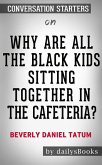Any reader can use this workbook for Why Are All the Black Kids Sitting Together in the Cafeteria? And Other Conversations About Race by Beverly Daniel Tatum and find immediate help in applying its major lessons.
Why Are All the Black Kids Sitting Together in the Cafeteria is a book in which Beverly Daniel Tatum inscribed her psychological approach to racism and her research about racial identity development. In this book, Tatum uncovered why children are seated in clusters when you enter into a racially mixed room, and shared her knowledge about identity and identity development which unfolds in adolescence. Why Are All the Black Kids Sitting Together in the Cafeteria, originally published in 1997, according to one of New York Times best selling authors, should be used as a conversation opener to talk about race in America.
Do you want to apply the major lessons to your daily life? The goal of this workbook is to help even the any reader apply what may be the most critical lessons found Why Are All the Black Kids Sitting Together in the Cafeteria? And Other Conversations About Race by Beverly Daniel Tatum.
Results have shown that learning is retained best through repeated hands-on applications. With Max Help Workbooks, readers will be able to find distilled information with applicable engaging exercise worksheets to maximize learning.
Don’t Miss the Following Content:
• Succinct breakdown of the book categorized into major lessons
• Read and use the exercises yourself or as a group
• Easy-to-understand analysis of each lessons distilled for even the newest of readers
• Simple and practical worksheets to further reader’s application
• Quiz questions as a resource to be used for yourself or others
Book is on sale now. Get your copy now and take out a pencil, pen, or whatever digital technology to annotate, implement and make changes manifest. And don’t forget to have fun - that’ll also keep you learning.
Disclaimer: This workbook is meant to further application as an unofficial companion guide of the original work and is not affiliated with, or intended to replace the original work in any way. We encourage readers to purchase the original work prior to purchasing this copy.
Why Are All the Black Kids Sitting Together in the Cafeteria is a book in which Beverly Daniel Tatum inscribed her psychological approach to racism and her research about racial identity development. In this book, Tatum uncovered why children are seated in clusters when you enter into a racially mixed room, and shared her knowledge about identity and identity development which unfolds in adolescence. Why Are All the Black Kids Sitting Together in the Cafeteria, originally published in 1997, according to one of New York Times best selling authors, should be used as a conversation opener to talk about race in America.
Do you want to apply the major lessons to your daily life? The goal of this workbook is to help even the any reader apply what may be the most critical lessons found Why Are All the Black Kids Sitting Together in the Cafeteria? And Other Conversations About Race by Beverly Daniel Tatum.
Results have shown that learning is retained best through repeated hands-on applications. With Max Help Workbooks, readers will be able to find distilled information with applicable engaging exercise worksheets to maximize learning.
Don’t Miss the Following Content:
• Succinct breakdown of the book categorized into major lessons
• Read and use the exercises yourself or as a group
• Easy-to-understand analysis of each lessons distilled for even the newest of readers
• Simple and practical worksheets to further reader’s application
• Quiz questions as a resource to be used for yourself or others
Book is on sale now. Get your copy now and take out a pencil, pen, or whatever digital technology to annotate, implement and make changes manifest. And don’t forget to have fun - that’ll also keep you learning.
Disclaimer: This workbook is meant to further application as an unofficial companion guide of the original work and is not affiliated with, or intended to replace the original work in any way. We encourage readers to purchase the original work prior to purchasing this copy.









